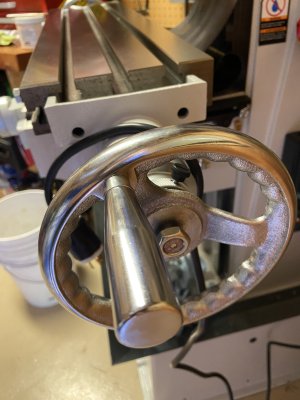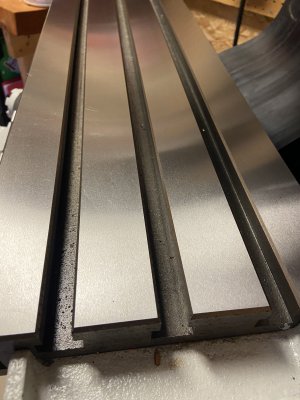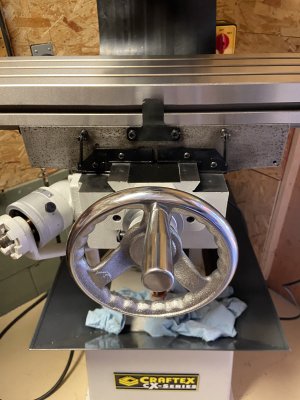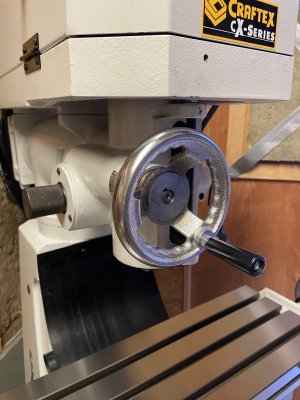Since you didn't blink at 10 grand, I'm not gunna hold back. Here is a starting suggested list. I listed the things I use regularly or that I consider essential. I'm sure I've forgotten a lot. I'm also sure others will disagree. That's ok by me. Especially if they add stuff!
All your tooling should be balanced to the size of your mill.
WORKHOLDING
Workholding is important. You say you have a vise already. I hope it's a good one. Not one of those they usually give you with the mill. Don't cheap out on the vise. Lots of guys love Kurt Vises. I have a Gerardi that I love. This is something to try and get used.
@RobinHood got a Chinese Clone of the Gerardi that he liked. The workpiece must be secured to the mill's table to prevent movement during cutting. This isn't just about good finishes, it's also about safety. Please get a good vise.
A set of T-nuts, studs, step blocks, and clamps that fit the T-slots on your mill's table. This is used for securing irregularly shaped parts or when a vise isn't suitable.
A set of precision 123 blocks. These are precision-ground steel blocks used for setup, squaring work, and raising the workpiece to a specific height. A set of these with the appropriate sized machine screws is incredibly useful. I have several sets and I also have a set of 246 blocks. I use them ALL THE TIME!
Parallels - precision ground steel paired bars of equal height, used in a vise to raise the workpiece and keep it parallel to the vise's jaws. You can get thin, standard, thick, and wavy sets. At a minimum, get a 1/8 standard set. Next wavy, then 1/4, and lastly thin.
Soft Jaws or something similar are replaceable jaws for your vise, often made of a softer metal like aluminum. They are used to hold delicate or previously machined parts without damaging them. You can make them if you want.
CUTTING TOOLS
End Mills. Don't run out and get too many of these all at once. Just get a few to begin with. Say two each of 1/4, 3/8, and 1/2. (or 6, 8 10 & 12mm). You can get square end, bottom cutting, side cutting, and ball end. You will use combined bottom/side cutting most often. It won't take long to know what you need and then you can buy more. Don't bother with roughing mills till later - if ever.
You asked about a fly cutter. I'd suggest that you get three. Large, Med, and Small. Or you could consider a few sizes of facing mills with indexable inserts instead. But don't go too big. And be careful to get ones that all share the same inserts.
A collet set - say ER40 or 32. You can buy R8 collets too, but I prefer ER collets and a few standard R8 end mill holders - not R8 collets. The ER style and R8 Endmill Holders are better than R8 collets in my opinion.
You will also need 1 or 2 drill chucks. I'd suggest a small chuck and a half inch chuck. Again, buy good ones. They don't need to be Albrecht, but they need to be decent not junk. I'd suggest Jacobs Ball Bearing with keys. But there are other good ones too.
Get a small high quality drill set to begin with. You can buy individual drills as you need them. Don't buy those big 117 drill sets. If they cost less than $500 they are prolly junk.
Also think about a reamer set.
And think about annular cutters too.
METROLOGY
Precision is what a mill is all about, and you'll need the right tools to achieve it.
A good set of calipers is your primary tool for measuring dimensions. A micrometer is essential for more precise measurements, especially on smaller parts.
Dial Test Indicator (DTI) is used for a variety of tasks, such as tramming the head of the mill (making sure it is perfectly perpendicular to the table), indicating a part's surface, and finding a bore's center. I like Mitutoyo but they are pricey. DTIs are for measuring runout and relative displacement.
Lots of guys also like plain dial indicators. These are what I call plunge indicators. These measure in absolute terms and are used for measuring displacements.
A magnetic base for indicators of both kinds will allow you to mount them securely to the machine. Noga is a really good brand of base that you will be glad you bought. Make sure you get the right size clamp for your indicator(s).
A Center Punch is used to mark the location of a hole before drilling. And a few Center Drills will be useful to start a hole that doesn't wander.
A carbide scribe and some Dykem.
A nice 12" and 6" machinists ruler with metric and imperial is very useful.
An edge finder is used to accurately locate the edges of your workpiece, allowing you to set the X and Y zeros or references for your cuts. Both mechanical and electronic versions are available. I like the electronic ones. Accusize makes a really nice one.
Think about a spindle indicator. I use mine all the time but some guys don't.
Metric and Imperial Thread Gauges.
MISCELLANEOUS
A good book on milling.
A recent copy of Machinery's handbook.
A dead blow and wrench for the drawbar.
A dead blow hammer for the vise if you don't get a Gerardi (which doesn't need one).
A good set of Imperial and Metric Allen Keys. Maybe a set of ball end too but that's not required.
A few different sizes of machinists squares - maybe also a 45.
A good Tap & Die set or maybe buy them individually as needed. You won't go wrong splurging on Starrett Tap Wrenches.
Also a tap follower (or make one)
Cutting fluids for steel and aluminium.
All the oils needed to maintain the mill. Usually spindle oil and way oil.
A swarf brush & dust pan
OPTIONAL STUFF
A flat/vertical rotary table.
A 5C Spin Indexer and collets.
A slit saw set
Gauge Blocks
Pin Gauges
Hole Center Punches
Transfer Punches
SOME DAY - or maybe now.....
3 or 4 axis DRO
X-Y and maybe Z power drives




